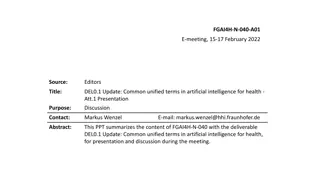
Data Sharing Practices in Healthcare
Explore the latest updates on data sharing practices and data sourcing in healthcare, focusing on the importance of connected structures and universal solutions. Learn about the objectives of the deliverable, best practices for secure data sharing, and the principles of sharing medical data at scale. Understand the necessary steps and requirements for enabling secure data sharing through centralized and distributed data sources.
Download Presentation

Please find below an Image/Link to download the presentation.
The content on the website is provided AS IS for your information and personal use only. It may not be sold, licensed, or shared on other websites without obtaining consent from the author. If you encounter any issues during the download, it is possible that the publisher has removed the file from their server.
You are allowed to download the files provided on this website for personal or commercial use, subject to the condition that they are used lawfully. All files are the property of their respective owners.
The content on the website is provided AS IS for your information and personal use only. It may not be sold, licensed, or shared on other websites without obtaining consent from the author.
E N D
Presentation Transcript
FGAI4H-S-047 Geneva, 3-5 July 2023 Source: Editor Title: DEL5.6: Data sharing practices Progress review presentation Contact: Ferath Kherif CHUV - LREN Switzerland This PPT discusses the latest updates made on the deliverable Updated DEL5.6: Data sharing practices + Data sourcing. E-mail: Ferath.kherif@chuv.ch Abstract:
Data Sharing and Data sourcing D5.6 Health is not a local problem and requires a connected structure, universal solutions, and joined principles
Data Sharing and Data sourcing Initial draft describes the objectives and proposes an initial outline of the planned deliverable Data Sharing Practices This deliverable aims to provide an overview of the existing best practices for data sharing of health-related data, including the requirement to enable secure data sharing and issues related to data governance. The documents described established solutions and novel approaches based on distributed and federated environments. Health is not a local problem and requires a connected structure, universal solutions, and joined principles
Data Sharing Principles Sharing medical data at scale is necessary to improve the development and adoption of artificial intelligence solutions for healthcare and to make these solutions more robust. Negotiate the balance between potential harm from sharing critical data and the potential benefit of improving care.
Data Sharing Principles Sharing data for appropriate and authorised purposes. Why the data is being used Sharing data only with authorised users.Who is using the data Using data in a safe and secure environment. Applying appropriate protections to the data.Where the data is being used Ensuring public outputs from data sharing projects do not identify the people or organisations in the data.
Data Sharing and Data sourcing Necessary steps and requirements to enable secure data sharing Methods for Data sourcing Centralized data sources Distributed data sources Health is not a local problem and requires a connected structure, universal solutions, and joined principles
Data Sharing and Data sourcing Necessary steps and requirements to enable secure data sharing Roles and responsibilities of the data providers, data processors & data receivers Data anonymization and de-identification Data minimization Data confidentiality, Data security and privacy Protection and Privacy assessments. Responsibilities of data providers and data receivers Necessary steps and requirements to enable secure data sourcing Description of data Data ingestion and update Health is not a local problem and requires a connected structure, universal solutions, and joined principles Results and dissemination of results including IA models
Best practices for data sharing/Sourcing Platform Data Catalogue & Search
Implement tools and define the processes data descriptions and intelligent use in the context of the FG - AI4H objectives, including ethical, annotation, and validation challenges. Discover / Capture Link Data Connect Data
High Level Architecture DATA Catalogue Cloud API ACCESS LAYER LOCAL DATA Devices
High Level Architecture DATA SPACES Semantic Layer- UMLS driven DATA Catalogue Cloud API ACCESS LAYER LOCAL DATA Devices
High Level Architecture DATA SPACES Semantic Layer- UMLS driven UMLS is developed by the National Library of Medicine (NLM) and integrates various biomedical vocabularies (SNOMED CT, ICD-10, ICD- 11, LOINC) and terminologies into a unified framework. FHIR resources (Patient, Condition, and Observation): create a structured and standardized representation of healthcare data
Metadata Components Technologies/Platforms tested Data search, data management - Data lineage support - Amundsen - DataHub - Atlas - CKAN - Magda - Federation Technologies/Platforms Selected/built Data search, data management + data lineage support +federation + Annotation metadata +link to ML model + Governance - - Manage data transfer according to privacy sharing principles (D5.6) - Advanced query capabilities according to context information. - data transfer to ML models Combined multiple approaches based on own development and Obiba.org suites : - MetaData capture - Data curation according to standards -Storage: ontologies/semantic based query - Publish data -Cloud based - Google DC - AWS -Azure Cloud computingoptimizationplatform Intelligent Data management
Data sourcing Own development and Obiba.org suites
Data sourcing Own development and Obiba.org suites
Data Access Request Data Quality DACQORD Principle
Data Curation Data Quality DACQORD Principle
PLAN Data Schema and Metadata Machine and human-readable data schema that includes metadata and contextual information Compatibility with existing healthcare data standards and regulations Federated Sourcing and Integration Federated sourcing from multiple countries Integration with open code AI platforms Data Quality and Validation Ability to execute queries and validate data quality Scalability and Security Scalability to handle large and diverse datasets Robust security and privacy measures to protect sensitive data User Interface and Accessibility Easy-to-use interface for data discovery and sharing Demonstration validation: showcasing its effectiveness of the federated approach
Thanks for your attention Contact Ferath.kherif@chuv.ch



